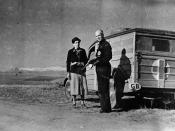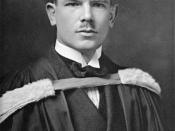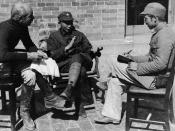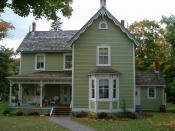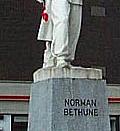Norman Bethune (1890-1939), a Canadian surgeon and a humanitarian, made a tremendous impact worldwide. He made a great contribution to Canadians, the Spanish in the Spanish Civil War, and the Chinese during the Sino-Japanese War. In many peopleÃÂs minds, he is a real hero.
Bethune aspired to become a doctor like his grandfather in his childhood. According to Brittain (1964), in the First World War, Bethune interrupted the medical studies in the University of Toronto (U of T) and volunteered to become a stretcher-bearer in France. After he was injured, he came back to Canada and resumed his study in U of T. After he graduated, he became a surgeon. His polished skills in curing tuberculosis (TB) came from his personal experience with the disease. In the 1920s, he caught TB. In the Sanatorium, he read a great dead of documents on TB and discovered a new method ÃÂpneumothoraxÃÂ to cure the kind of disease.
ÃÂHe successfully underwent an artificial pneumothorax, which was considered a new, radical treatment at that timeÃÂ (Wilson, 1951, p.58-59). After he pulled through, he became an expert in TB and thoracic surgery. From 1929, he began work for the Royal Victoria Hospital in Montreal where he improved his skills as a thoracic surgery. Bethune developed or modified a number of medical and surgical instruments then, including ÃÂthe modified rib stripperÃÂ, ÃÂthe Pleural PoudrageÃÂ and ÃÂthe Bethune rib shearsÃÂ. ÃÂthe Bethune rib shearsÃÂ is his most famous invention and still prevail in thoracic surgery today. At the same time, he ÃÂtaught prescription writing and published 14 articles on thoracic techniqueÃÂ (Pinkerton, 2003, p.2066). Bethune also showed his socialist views then. He wanted the state was responsible for public health in Canada and advised ÃÂuniversal health careÃÂ. In 1936, he established the first furthering socialized medicine group in Canada, the Montreal Group for the Security of the People's Health. The group was sponsored by medical personnel and it comprised of one hundred medical and social workers. The Group provided medical services for all people especially the poor and it made some plans for the province health care based on BethuneÃÂs proposal. These plans included ÃÂa system of municipal medicine, compulsory health insurance, voluntary health insurance and care of the unemployed.ÃÂ (Stewart, 1973, p.76-77). Meanwhile, Bethune was an advocate for women's rights. John Wilson cited his letter as follow:Women have been slaves too long. I am tired of idiots who try to keep 'explaining' the female mind. The female mind is the human mind. Under inhuman conditions it will suffer. The myths created about the so-called female mind are kept alive by men who would like to keep women in bondage (Wilson, 1951, p.148).
In addition, Bethune loved arts and valued the arts education. He set up a free art school, The Children's Art School of Montreal, for children in his house together with his fellow Canadian artists Fritz Brandtner and Marion Scott.
During the Spanish Civil War in 1936, Norman Bethune aided the Spanish greatly. His invention of new medical equipments has saved hundreds of thousands of lives. In the Spanish War, the Committee to Aid Spanish Democracy sent Bethune to Spain as the leader of the Canadian Medical Unit. On November 3, Bethune left for Madrid, where he showed strong creativity and leadership. He rapidly established a blood transfusions organization which could supply the whole 1000-kilometre-long Madrid front line. The blood transfusions organization included a staff of 25, several blood labs and blood banks and an ambulance. As the blood transfusions organization was used, blood from donors could be collected in the blood labs in the city and immediately transferred to the battlefield. Therefore Bethune and other doctors transfused the blood into the wounded at once. The introduction of the blood transfusions organization has a high place in the history of medicine. Besides the blood transfusions, Bethune also developed the first mobile medical units in the world, which was the model of Mobile Army Surgical Hospital widely used during wars and disasters. The mobile medical units were made up of bandages, medicine, and supply enough for hundreds of operations. The function of the unit was to make medical workers closer to the front, in order that the wounded could be treated sooner. Owing to these medical inventions, casualty rate in the Spain Civil War were reduced speedily.
While Sino-Japanese War broke out, Bethune went to China assisting the Chinese. He continued to apply and improve his invention of new medical equipments in the war filed. Bethune saved uncountable lives in China and rendered up his life for the Chinese. ÃÂWorking with the China Aid Council and the China Defense LeagueÃÂ (Wilson, 1951, p.111), in1938, Bethune led a medical unit to Northern China which was withstanding the fierceness of attack of the Japanese. Bethune continued to enlarge the scale of the blood transfusions unit and mobile medical units at that time. He improved mobile medical units to a portable operating theatre which could be carried on two mules and led his medical units to the front to operate the wounded under heavy gunfire. After nearly all the hospitals and the buildings were bombed by the Japanese, Bethune and his fellow medical workers changed a temple to an operating theatre where he operated the wounded around the clock. According to the Bethune Memorial House National Historic Site of Canada (2007), ÃÂBethune operated at a prodigious rate; once he operated on 115 cases in 69 hours without stopping even when under heavy artillery fire.ÃÂ In addition, he trained thousands of medical workers and helped the Chinese to construct the ÃÂModel HospitalÃÂ. Unfortunately, on late October, 1939, Bethune cut his finger in a surgery and contracted septicemia, blood poison, because of lack of rubber gloves. At that time, it is impossible to find medicine to cure Bethune in China. He died on Nov.12th 1939. He became a martyr and a hero in the ChineseÃÂs estimation. Stewart cited Mao Tse-tung, Chairman of China,ÃÂs writing, In Memory of Norman Bethune as follow:We mourn more than the passing of a man. Dr. Bethune's devotion to the people is a lesson for all. [Bethune was] a man of importance, integrity, of virtue who forsakes self-interest for the interest of the people. The death of comrade Bethune is a great bereavement. The Chinese nation will recall him with love and admiration (Roderick cited Mao, 1973, p.164).
The Chinese reconstructed the ÃÂModel HospitalÃÂ and named it ÃÂthe Bethune International Peace HospitalÃÂ to revere the memory of Bethune.
In 1972, the Canada federal government declared him "a Canadian of national historical significance." and constructed the Bethune Memorial in his hometown, Gravenhurst, Ontario and it was opened in 1976. ÃÂIt stands as a reminder of Bethune's dedication and self-sacrificeÃÂ. (Bethune Memorial House National Historic Site of Canada, 2007)Bethune was both a great doctor and a humanitarian. From advocating universal health cares in Canada to innovation in military medicine, Bethune devoted his whole life to benefiting mankind. His noble selfless humanitarianism has had a profound influential on many people worldwide.
REFERENCESBrittain, D. (1964). Bethune. [Film].National Film Board of Canada.
Bethune Memorial House National Historic Site of Canada. (2007). Parks Canada.
Retrieved on Mar. 6th 2008 from http://www.pc.gc.ca/lhn-nhs/on/bethune/natcul/natcul1_E.aspPinkerton, P.H. (2003). The mind of Norman Bethune. The Journal of the American Medical Association, 290 (15), 2066.
Stewart, R. (1973). Bethune. Toronto: Alger Press.
Wilson, J. (1951). Norman Bethune: a life of passionate conviction. Montreal: XYZ Publishing.

